Two wineries in southern Italy: One clinging to a sheer rock face above the Amalfi Coast in Campania, the other spread across the Salento plain in Puglia. Both wineries grow indigenous grapes with training or planting systems devised by the Romans: One with vines draped on pergola frames perched on narrow terraces, the other with Alberello, or head-trained vines, arranged in a hexagonal pattern called settonce. Both wineries are family owned. The winery on the Amafi Coast is Cantina Marisa Cuomo. The Puglian winery is Masseria Li Veli. I enjoyed the privilege of visiting both during a recent family vacation.
Amalfi Coast: Cantina Marisa Cuomo, Furore
As we were winding our way from Naples to Amalfi, we passed through the tiny community of Furore, where our driver pointed out Cantina Marisa Cuomo as we whizzed by. He noted that they made very good wines. A short time later, we met our family at Bistro Bar Baglio just outside the town of Amalfi. With a Campari spritz in hand to console my queasy 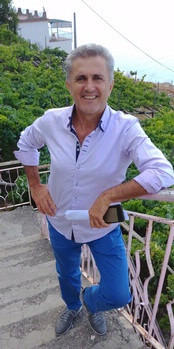 stomach, I was admiring the wines on display. The manager pointed to a bottle that he said was the best wine of the area. It was from Cantina Marisa Cuomo.
stomach, I was admiring the wines on display. The manager pointed to a bottle that he said was the best wine of the area. It was from Cantina Marisa Cuomo.
The winery, established in 1980, is owned by Andrea Ferraioli and Marisa Cuomo. They work with about 25 acres of grapes, over 8.5 acres being their own, with the remaining acres owned by contracted growers. They specialize in indigenous varieties with red wines made from Aglianico and Piedirosso, and whites made from Falanghina and Biancolella. Their icon wine is a white made from Fenile, Ginestra and Ripoli, grapes thought to be grown only on the Amalfi Coast.
While we hadn’t planned any winery visits, we made a spur-of-the-moment decision to visit the winery, which meant that we really didn’t have time to make an appointment. So, we took a chance and just showed up–with a group of 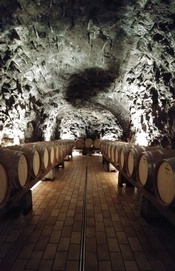 six, no less. Fortunately, they were very gracious and invited us join a short tour that was just getting started.
six, no less. Fortunately, they were very gracious and invited us join a short tour that was just getting started.
The winery is built into the steep hillside and makes maximum use of a small space. The bottling line was labeling and boxing bottles. The stunning barrel rooms were carved into the dolomitic-limestone rock, a project that took 20 years, with a large portion of that time devoted to getting a permit to build it.
We visited one of the vertigo-inducing, terraced vineyards close to the winery. It measured about 12 feet from the back to front and maybe 20 feet from side to side. Needless to say, any work in this vineyard work is done by hand. The pergola frame was created with logs from local trees tied together with twigs. Interestingly, this particular 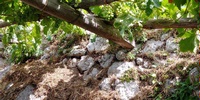 terrace was planted with different grape varieties including red and white, harvested at different times.
terrace was planted with different grape varieties including red and white, harvested at different times.
We didn’t taste wines at the winery, but we had already taken the advice of our host at Bar Baglio and purchased a few. The Costa d’Amalfi DOC, Furore Bianco 2016 ($24) made from the previously mentioned Falangina and Biancolella is the ideal wine for a hot day: Fresh, crisp and lively. It has aromas and 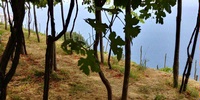 flavors of white peach and Meyer lemon with notes of fresh herbs, round in the mouth with zesty acidity. As noted on the label the grapes are grown in Furore.
flavors of white peach and Meyer lemon with notes of fresh herbs, round in the mouth with zesty acidity. As noted on the label the grapes are grown in Furore.
Marisa Cuomo, Costa d’Amalfi DOC, Fiorduva 2014 ($65) is the shining star made from the local varieties, 40% Ripoli, 30% Fenile, and 30% Ginestra. The grapes are picked late, so they are quite ripe. It is barrel fermented and spends nine months or so in oak with another six months in bottle before release. It is an exciting wine with round, ripe, rich and layered pineapple, melon, lemon marmalade fruit in tense juxtaposition with brilliant, citrusy acidity. A bit of trivia about the Fenile grape is that is has the same chemical compound (TDN for short) that gives the “fusel” or “petrol” character to Riesling.
Several companies import these wines to the US, including Vinity Wine Company, CA and Panebianco, NY.
Puglia: Masseria Li Veli, Cellino San Marco
We left the family and drove to Ostuni in the Brindisi Province of Puglia for a couple of days before we returned home. About an hour’s drive to the south is the small village of Cellino San Marco, where we met with Alfredo Falvo to visit Masseria Li Veli.
If the Falvo name is familiar, you may remember that they owned Avignonesi, a winery estate in the Montepulciano area of Tuscany from 1974 to 2008. They bought the Li Veli property in 1999 because they thought it had great potential for high quality wines and would give them more room to grow. Alfredo said they could have gone to other areas like Bolgheri, but Puglia offered more freedom of opportunity. He said, “The 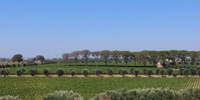 area has great climate and soil, unique indigenous grape varieties and people with a culture and knowledge of grape-growing, but not as much know-how with wine making.”
area has great climate and soil, unique indigenous grape varieties and people with a culture and knowledge of grape-growing, but not as much know-how with wine making.”
It took ten years to develop the property, buildings and vineyards, step by step, and they officially started production in 2009. They had drawings of the original buildings, which were erected in 1895 as a masseria, an agricultural fortress big enough to house the farmer’s family as well as the workers. These drawings helped guide the restoration and renovation of the buildings for modern wine making. It is an impressive and enormous structure.
They have plenty of modern wine making equipment and processes. Ten 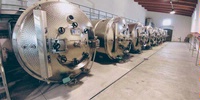 rotary fermenters are used to ferment the white and rose wines for quick and gentle juice extraction, oxidation prevention, as well as color management. Cap management and color extraction for reds is accomplished by the delestage, or rack-and-return method. Fermenting juice is drained from the tank into another container, then pumped back into the tank. This process can also allow for seed removal to prevent bitterness.
rotary fermenters are used to ferment the white and rose wines for quick and gentle juice extraction, oxidation prevention, as well as color management. Cap management and color extraction for reds is accomplished by the delestage, or rack-and-return method. Fermenting juice is drained from the tank into another container, then pumped back into the tank. This process can also allow for seed removal to prevent bitterness.
The vineyards are planted in blocks surrounded by trees. Most of the vines are head pruned and planted in the settonce pattern, six vines equidistant from one another while surrounding a seventh, central vine. As Alfredo 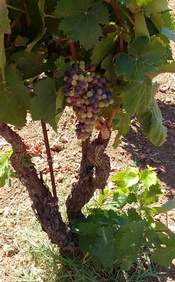 pointed out, the pattern is like the cells of a beehive. This spacing allows each vine to have space above and below ground as well as equal opportunity for sun. The soils are sandy with a calcareous base, so the top soil drains well, while the calcareous base holds water to provide a water supply to the roots.
pointed out, the pattern is like the cells of a beehive. This spacing allows each vine to have space above and below ground as well as equal opportunity for sun. The soils are sandy with a calcareous base, so the top soil drains well, while the calcareous base holds water to provide a water supply to the roots.
After a tour of the winery and a brief visit to a vineyard, we had an opportunity to taste a few of their wines. First up was a Verdeca from the Falvo’s Askos project to grow and make wines from ancient varieties that have almost disappeared. The Valle de Itria IGT, Askos Verdeca 2016 ($17) is an intriguing wine with bright citrus, pear and fruit and notes of fresh herbs. It shows medium body and has a touch of salty mineral character in the finish.
Li Veli, Salice Salentino DOC, Riserva, Pezzo Morgana 2014 ($17) is an amazing wine for the price. It is warm, rich and ripe with spicy black cherry, blackberry, plum compote fruit and notes of toffee. It has a solid 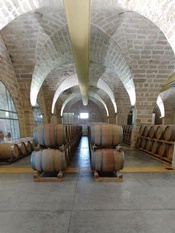 structure of acidity to brighten the bold flavors and dusty tannins to provide a steely backbone. It’s made from single variety aged 12 months in French oak barriques.
structure of acidity to brighten the bold flavors and dusty tannins to provide a steely backbone. It’s made from single variety aged 12 months in French oak barriques.
Masseria Li Veli, Salento IGT, Aleatico Passito 2009 is is probably not available in the USA, but I just have to tell you about it. It is one of the most impressive passito wines I have ever experienced. It had aromas of balsamic, orange zest, dried herbs, sweet flavors of dried apricots, dates, and an intense continuing the balsamic theme. It had weight and velvety texture, then it finished clean, with lightness and elegance showing no off flavors or aromas. Despite the high sugar level, the wine was not at all cloying. The Falvo’s deft hand at passito should come as no surprise. In Tuscany, they produced several Vin Santo wines, most notably a highly regarded Occhio di Pernice made with a portion of Prognolo Gentile, a Sangiovese clone.
Connect with her on Twitter at @RebeccaOnWine
